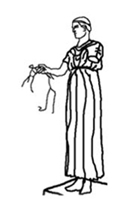
Design about
the
Charioteer of
Delphi, around 470 B.C., bronze, height 180cm
his hightech
vehicle he approaches those limits to
'nature', to
"originality', to brutishness, to insanity
and divinity which
he
himself has drawn to identify and to constitute himself
as human
being
as being different to those areas. The
'approaching of this border is feared and at the same
time longed for
as a path to life without delay' (Derrida). Insanity is the
love for beauty,
a perfect control of the vehicle the
complete happiness that one needs to see the ideas, as
defined by Phaidros.
The skeptical backside of this motorcycle hymn is the phrase of the so-called dromological stillstand (from classical Greek DROMOS/racecourse and LOGOS/science, "logic of the run').
It may be understood as effect of self blockade. Everyone has at least one car, one bicycle, two telephones and at least an e-mail account. More easily reachable in the sense of an intensive communication one does not become through these, neither more beautiful. Even though one turns the wheel all day long.
This dromological still stand does not correspond with the spoken about potentiality of the Delphic charioteer nor with the bursting feeling of (Ueber-)Lebens (please refer to comment to this term on page before this) in present closeness to death but with the pitiful loss of controll of the subject within a smoothly working system. The common statement of the system administrators is of course a different one. They still claim and spread with success increased phantasies of steering. A rather harmless example of such touched-up steering slogans is "Willkomm Höft." * Steering slogans are liked to be cushioned through cultural history, anyhow the crucial employment of culture is the processing by quotation to sanction any interest no matter what connection.
So in Schulau it quaks out of the loudspeakers of the welcoming installation for ships: Steuermann, halt die Wacht! (helmsman keep watching); when one looks at the libretto of Wagner's opera one discovers with surprise that there it says: Steuermann lass die Wacht! (helmsman don't bother watching)
But peddled though is "Steuermann, halt die Wacht!", it is less dangerous because in "Fliegender Holländer" (The flying dutchman) an unprecedented catastrophe is unfolding after the helmsman leaves his watch.
At Wagner everything is at sixes and sevens so one changed the text and ever since nothing is topsy-turvy any longer - it is as simple as that.
"One" sucks the lemonade with pleasure, shuffles a piece of tarte in the mouth and stares at the Willkomm Höft passing silly freight ships, the helmsman is not seen most of the times, but one trusts in the skill of the river pilots.
*"Willkomm Höft" is the name of an institution to welcome ships coming into the Hamburg Harbour, it is located in Schulau near Wedel/Hamburg,G. Loudspeakers greet incoming and outgoing ships loudly with music and words. On the banks of the river there is a restaurant where one can experience the greetings whilst enjoying coffee and sweets.
The skeptical backside of this motorcycle hymn is the phrase of the so-called dromological stillstand (from classical Greek DROMOS/racecourse and LOGOS/science, "logic of the run').
It may be understood as effect of self blockade. Everyone has at least one car, one bicycle, two telephones and at least an e-mail account. More easily reachable in the sense of an intensive communication one does not become through these, neither more beautiful. Even though one turns the wheel all day long.
This dromological still stand does not correspond with the spoken about potentiality of the Delphic charioteer nor with the bursting feeling of (Ueber-)Lebens (please refer to comment to this term on page before this) in present closeness to death but with the pitiful loss of controll of the subject within a smoothly working system. The common statement of the system administrators is of course a different one. They still claim and spread with success increased phantasies of steering. A rather harmless example of such touched-up steering slogans is "Willkomm Höft." * Steering slogans are liked to be cushioned through cultural history, anyhow the crucial employment of culture is the processing by quotation to sanction any interest no matter what connection.
So in Schulau it quaks out of the loudspeakers of the welcoming installation for ships: Steuermann, halt die Wacht! (helmsman keep watching); when one looks at the libretto of Wagner's opera one discovers with surprise that there it says: Steuermann lass die Wacht! (helmsman don't bother watching)
But peddled though is "Steuermann, halt die Wacht!", it is less dangerous because in "Fliegender Holländer" (The flying dutchman) an unprecedented catastrophe is unfolding after the helmsman leaves his watch.
At Wagner everything is at sixes and sevens so one changed the text and ever since nothing is topsy-turvy any longer - it is as simple as that.
"One" sucks the lemonade with pleasure, shuffles a piece of tarte in the mouth and stares at the Willkomm Höft passing silly freight ships, the helmsman is not seen most of the times, but one trusts in the skill of the river pilots.
*"Willkomm Höft" is the name of an institution to welcome ships coming into the Hamburg Harbour, it is located in Schulau near Wedel/Hamburg,G. Loudspeakers greet incoming and outgoing ships loudly with music and words. On the banks of the river there is a restaurant where one can experience the greetings whilst enjoying coffee and sweets.